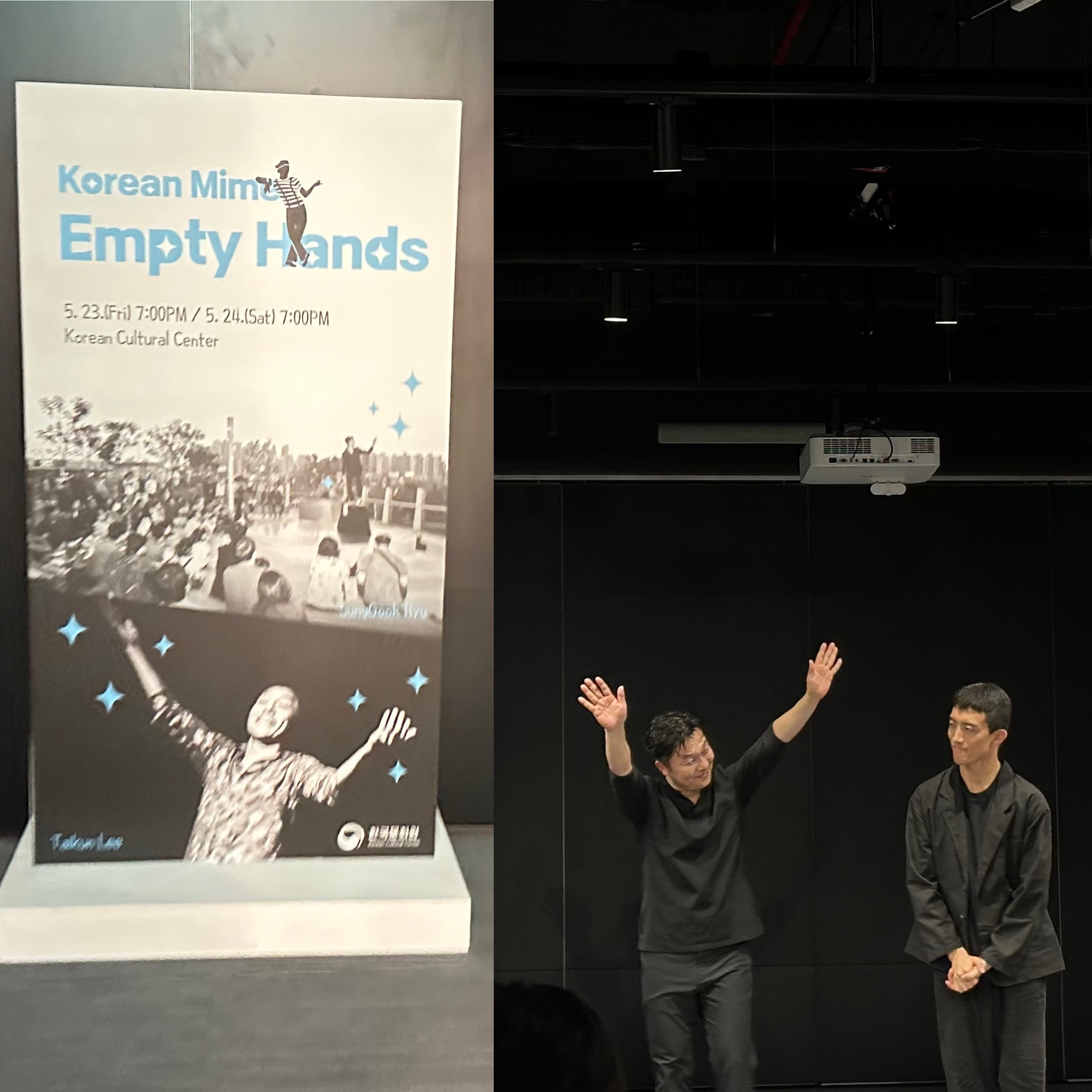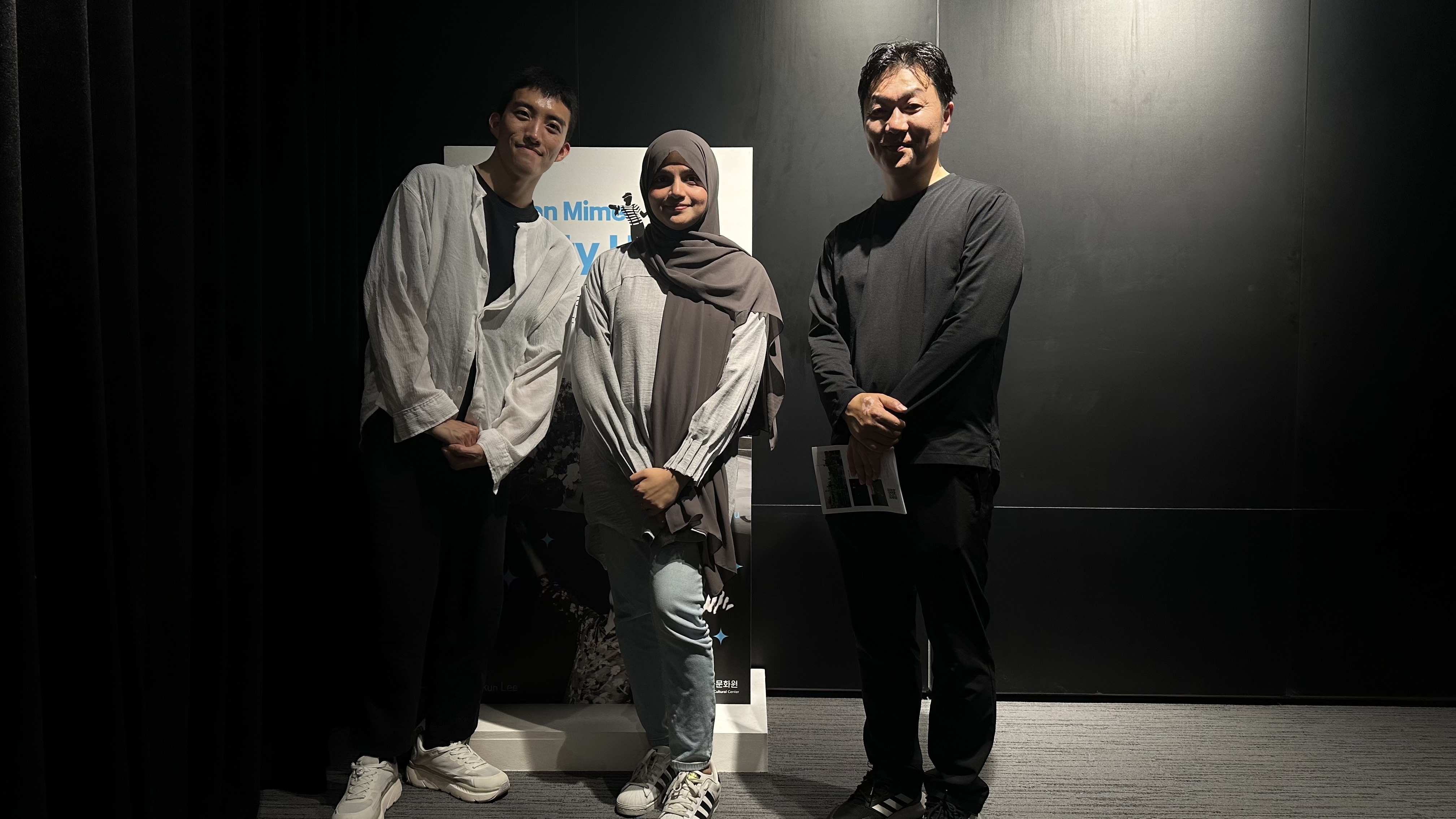The Korean Cultural Center in Abu Dhabi became a silent theater of intense emotion and narrative on May 23rd and May 24th 2025. It was a memorable experience for many audience members who had never seen a live mime performance before. Using only body language, attitude, and pure talent, renowned Korean mime performers Taikun Lee and SungGook Ryu enthralled audiences with eight separate acts. They explored the most secret hidden corners of the human experience without saying a word, eliciting thinking, comedy, and tremendous emotional resonance.

Graduate of the École de Mimodrame de Paris Marcel Marceau, Taikun Lee blends European mime traditions with Korean themes in his work with a refined sensitivity. Regarded as one of Korea's top pantomime performers, SungGook Ryu is renowned for his emotional depth and exquisite skill. From "Wall," a tale of tenacity and achievement, to "Flight," a dreamer's quest for the impossibly possible, and the heartwarming conclusion that covered the entire life cycle from birth to farewell, they collectively presented a diverse array of acts. Even while each piece was independent, taken as a whole, they created a greater meditation on the fragility and beauty of life.
The silent power of the evening was what really set it apart. Silence may speak louder than words, as this performance reminded us in a world full of noise. Lee and Ryu's expressive movement and open hands encouraged us to pause, explore deeply, and recognize ourselves in the stories that were being spoken. On the same day as the show, which is May 23rd, at the venue, I had the opportunity to take a picture with them and speak with them one-on-one, interview them. Throughout our entire talk, Ewha Kim from KCC, Abu Dhabi served as our mediator, translating between Korean and English.
What inspired you to pursue mime, and how did you both begin doing it?
Taikun Lee: When I first started mime, I performed mostly for myself. I used to believe that acting and using words were critical components of performing. But I eventually discovered that you can express yourself just as well without speaking. Silence becomes a strong aspect of your performance—not just for others, but also for yourself.
SungGook Ryu: My career began with theater acting. But at some time, I got a thought: what if I wanted to perform by myself? That question prompted me to mime. Nobody taught me how to mime when I first started. I started exploring and developing it on my own.
Did you take any particular courses to learn mime, or did you have any official training?
Taikun Lee: Anyone can mime if they really want to. To become a mime artist, you do not need a particular certificate or professional instruction; all you need to do is attempt it.
SungGook Ryu: You can simply begin, and if you have the desire, you can become a mime artist. There is no formal certification or institution necessary. However, there are universities and particular courses where you can learn mime professionally. I attended a university and studied theater and physical acting. Later, I continued my studies in France, where I studied physical acting, which greatly aided in the development and refinement of my mime talents.
Given that mime originated in France, were there any artists that influenced you, particularly French mime performers?
Taikun Lee: The beginnings of mime are unclear; we don't know where it started. Mime-like performances have long existed in various cultures, including Korea and Europe. However, it was in France that mime was fully developed and honed as an art form.
SungGook Ryu: When I was 20, I studied in Paris and was heavily affected by the French form of mime. But now I'm working on developing a distinct Korean version of mime. I'm constantly thinking about how to adapt and expand the French style to better reflect Korean culture and storytelling. After today's performance, I believe I've taken a significant step toward accomplishing that aim.
When was the first time you gave a public performance? And how did the crowd respond if it took place in Korea?
Taikun Lee: (Laughs) I can't remember my first public performance.
SungGook Ryu: My first performance was approximately 16 years ago, during my university years. The next year, I had the opportunity to perform at the Edinburgh Fringe festival. Because mime is a nonverbal art form, the audience reaction is typically same, whether in Korea or Europe. In fact, I've discovered that my performances elicit the same emotional and universal response from people all around the world.
Since Mr. Lee employs sound in his performances and Mr. Ryu includes comedy, which approach do you think is more difficult—and why?
Taikun Lee: There are many different types of mime, including those we performed today. The most difficult aspect of miming for me is the comic approach. You must make the audience laugh, not with words, but with your gestures and expressions. It's not enough to be goofy; you must create a setting that is both humorous and sympathetic, all without speaking. That type of humor-driven storytelling is considerably more difficult for me to convey.
SungGook Ryu: I see things slightly differently. I believe that when people are down, they look for something amusing to raise their spirits. When people are already satisfied, they look for something deeper or more important. For me, the problem is determining what the audience expects from my performance. The most difficult aspect of practicing mime is determining their expectations and emotional condition. That connection—knowing what they are seeking for—is never simple, but it is necessary.
This was your first performance in the UAE; how was the experience? How did the audience react, and do you see that answers vary by country?
Sunggook Ryu: As previously stated, I did not detect much of a difference with the UAE audience. Regardless of where I travel in the world, the reception to my mime performances is very consistent. There was nothing special about today's audience, but I usually attempt to sense and connect with them during the performance. I concentrate on reading their energy and modifying in the moment based on what I see they are responding to.
Whereas Mr. Taikun Lee's presentation involved more audience participation? How did you feel about it, and how did the audience react after participating in your act?
Taikun Lee: Audience contact is a planned component of my presentation. I purposefully incorporate it into the act. Today, I had a fantastic experience with the UAE audience—they were interested, open, and responded to very well. That type of contact adds a unique vitality to the performance, and I felt really pleased about it.

Reflecting on their experiences abroad, both artists, Mr. Lee and Mr. Ryu, pointed out that because mime is nonverbal, audience responses to it are generally the same. According to SungGook Ryu, his biggest issue is figuring out what spectators emotionally require from a performance, and his audience reactions are constant across cultural boundaries. Taikun Lee, whose performances frequently incorporate prearranged audience participation, expressed his satisfaction with the UAE audience's participation, emphasizing how live interaction gives a performance more vitality and nuance.
How about this article?
- Like3
- Support1
- Amazing0
- Sad0
- Curious0
- Insightful1


